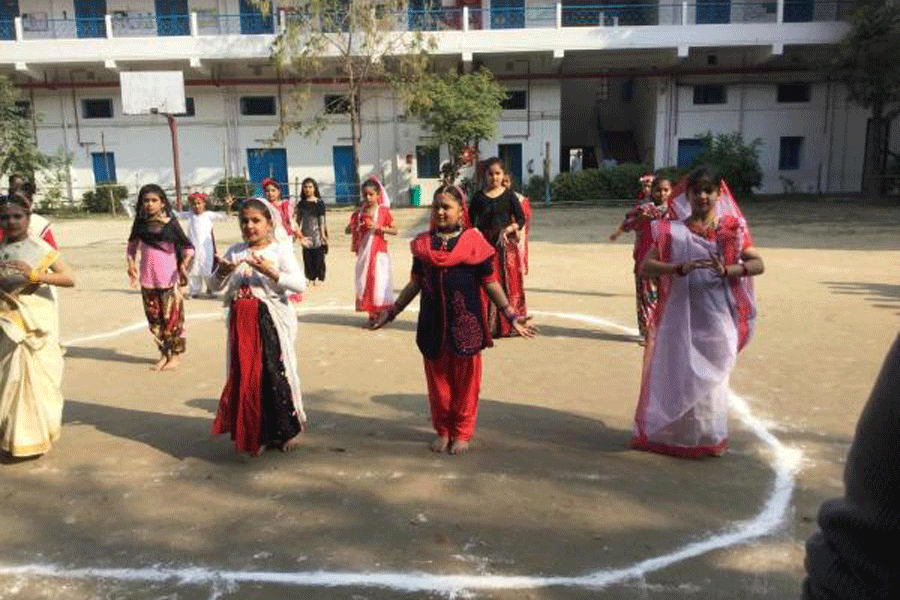The Jewish Girls’ School (JGS) on Park Street started out in 1881 as a learning centre of Hebrew religious principles with only 18 students. It has a twin — also founded in the late 19th century — the Elias Meyer F.S. & T.T. or the Jewish Boys’ School located in Bowbazar. There used to be a third school, the Jesuit Free School, for those from financially weak backgrounds and it was only up to Class V.
All three schools were located in central Calcutta, close to the synagogues and close to where the Jewish community lived.
Recalls Flower Silliman, 94, possibly the oldest surviving alumna of the girls’ school, “Our school used to have Anglo-Indian teachers who taught history, geography and English literature. There were five or six Jewish teachers, all women; they taught Hebrew and the scriptures. The school did not teach Hindi or any other Indian language. We were taught French instead. The office staff and bearers were Muslims.”
When Flower’s grandfather Saleh Abraham arrived in Calcutta from Baghdad in the mid-1860s, there were no Jewish schools here. But by the time the century turned a corner, the Jewish population in the city had grown. There were Jews from Burma and the Far East who came during World War II, and there were Jews from West Asia, known as Baghdadi Jews because they followed the liturgy of Baghdad. There were 5,000 Jews at one point and that was the highest.
Orthodox Judaism follows a matrilineal principle. Says Jael Silliman, a board member of the school, “The missionary schools in Calcutta were prone to proselytisation and to avoid it, the Jewish community members wanted to build a girls’ school for their own.”
The other two schools also came up around the same time. But today, while the boys’ school has students from both Hindu and Muslim communities, most of the students of the girls’ school are Muslims. The teachers and school staff are again from a
mix of faiths and only the members of the school boards are Jewish. The free school closed down along the way.
Jael Silliman says, “While JGS maintained a more or less British curriculum, the school’s mission was to provide its students with a Jewish education… the school atmosphere was relaxed, informal and Baghdadi in character. The students did not wear uniforms and the teachers taught from comfortable armchairs. Students studied the Tanakh and recited their prayers in Hebrew...”
JGS excelled under the leadership of Miss Ramah Luddy, who served as its principal from 1929 to 1964. Upon returning from England with a master’s degree in education, she enforced greater discipline, introduced uniforms and physical education, and made gym mandatory.
Flower remembers that though there were about 150 students in her school when she joined, only six people appeared for the Senior Cambridge exams. “Once they finished Junior Cambridge, most of the girls would start working as stenos and typists, telephone operators and nurses,” she says.
Post Independence, the numbers of Jews whittled down — 600 in the 1970s, 25 now. Both the girls’ and boys’ schools continued to function, albeit with tweaks to their configuration. After Miss Rodda, the last teacher to teach Hebrew, retired in the 1970s, Hebrew was discontinued.
“As JGS is adjacent to what is now a predominantly Muslim neighbourhood, members of the Muslim community started sending their daughters,” says Jael.
Sunsann L. Iyer, 58, is from the batch of 1982-83. She says, “Ours was the last batch to have Jewish students. Almost 85 per cent of the students were Muslims.”
Flower recalls a time when the cooks in Jewish households were always Muslims. The bearers who would carry tiffin carriers full of homecooked meals to some of the students were known as “khana coolies” and also belonged to the Islamic faith. Today, the staff of all three synagogues in Calcutta are Muslims.
There are only a few Jewish symbols left in the school. The four houses are named after the Jewish founding members. Yellow House after Mrs Rama Luddy, Red House after E.M.D. Cohen, Blue House after Elia David Joseph Ezra and Green House after Elia Shalome Gubbay. In the school hall, there are large framed portraits of eminent members of the community and wooden plaques with the names of the Jewish girls who graduated each year. Flower’s name is on it. The school uniform has a logo of the Star of David, and so does the gate. There is a mezuzah at the entrance to the staff room and the school still observes Jewish holidays.
Jael says, “Our students are mostly first-generation learners. The parents send them to our school without any apprehensions. It is how Jews and Muslims have lived here for more than two centuries. I pray, despite what happens in the rest of the world, our relationship will continue to be based on mutual respect and shared traditions.”
